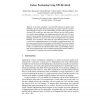Free Online Productivity Tools
i2Speak
i2Symbol
i2OCR
iTex2Img
iWeb2Print
iWeb2Shot
i2Type
iPdf2Split
iPdf2Merge
i2Bopomofo
i2Arabic
i2Style
i2Image
i2PDF
iLatex2Rtf
Sci2ools
PERVASIVE
2010
Springer
2010
Springer
Indoor Positioning Using GPS Revisited
It has been considered a fact that GPS performs too poorly inside buildings to provide usable indoor positioning. We analyze results of a measurement campaign to improve on the understanding of indoor GPS reception characteristics. The results show that using state-of-the-art receivers GPS availability is good in many buildings with standard material walls and roofs. The measured root mean squared 2D positioning error was below five meters in wooden buildings and below ten meters in most of the investigated brick and concrete buildings. Lower accuracies, where observed, can be linked to either low signalto-noise ratios, multipath phenomena or bad satellite constellation geometry. We have also measured the indoor performance of embedded GPS receivers in mobile phones which provided lower availability and accuracy than state-of-the-art ones. Finally, we consider how the GPS performance within a given building is dependent on local properties like close-by building elements and materials...
Applied Computing | Indoor Gps Reception | PERVASIVE 2010 | State-of-the-art Receivers Gps | Usable Indoor Positioning |
Related Content
| Added | 28 May 2010 |
| Updated | 28 May 2010 |
| Type | Conference |
| Year | 2010 |
| Where | PERVASIVE |
| Authors | Mikkel Baun Kjærgaard, Henrik Blunck, Torben Godsk, Thomas Toftkjær, Dan Lund Christensen, Kaj Grønbæk |
Comments (0)

